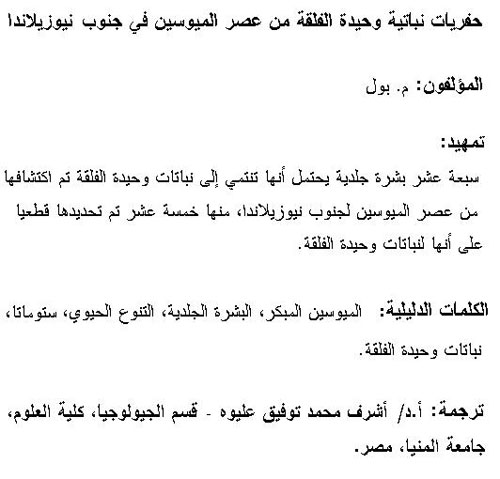|
Monocot MacrofossIls from the Miocene of Southern New Zealand Twenty million year old monocot fossils from New ZealandAbout 20 million years ago, southern New Zealand was a low-lying landmass. Inland there was a large fluvial-lacustrine basin (represented by the Manuherikia Group of rocks). On the southern coastline a swampy delta (represented by the East Southland Group of rocks) possibly represent the drainage of the interior basin. A wide variety of plant fossils are now known from both deposits. These include fragments of leaf cuticle–the resistant skin of the leaf. These retain an impression of the various cells that make up the epidermis, including the stomata, which are pores allowing gases to come and go from inside the leaf, as well as features such as hairs or glands. The various patterns of these cells are valuable in identifying the taxa represented by the leaf cuticle. One of the major groups of flowering plants is the monocots. These plants often grow in wetland environments, but their leaf cuticle is typically very thin, so if it is found at all in fossil deposits, it is usually uncommon. This study presents the fossil monocot cuticle, which has been found in the two geological basins in southern New Zealand. It provides an additional window into the biodiversity and ecology of the plant communities which grew in the basins. The plants identified include the bulrush, or cattail (Typha, also present as seeds), a lily (Astelia), screw-pine (Pandanus), and supplejack (Rhipogonum). Resumen en EspaĎolMACROF█SILeS de monocotiled█neas del Mioceno del sur de Nueva Zelanda Las cut╠culas de monocotiled█neas son un componente muy poco comÖn de las asociaciones de cut╠culas dispersivas del Mioceno de Nueva Zelanda, un hecho mĚs bien debido a su naturaleza generalmente frĚgil. Sin embargo, 120 asociaciones f█siles procedentes de dos regiones, la cuenca interior de Manuherikia (Otago central) y el paleodelta de Southland Coalfield, han producido diecisiete tipos morfol█gicos de cut╠cula, quince de los cuales son claramente monocotiled█neas. Őstos se describen como parataxones, y se considera que incluyen Astelia, Arecaceae, Rhipogonum, Pandanaceae, y Typha. La mayor╠a de los f█siles permanecen sin identificar, pero son probablemente plantas semiacuĚticas de pantano. Tambi╚n se ilustran 6 formas de semillas de Typha f█siles. PALABRAS CLAVE: Mioceno inferior, cut╠cula, biodiversidad, Stomata, monocotiled█nea Translator: Manuel Salesa R╚sum╚ en Fran┴aisMacrofossiles de monocotyl╚dones du Mioc╦ne du Sud de la Nouvelle-Z╚lande La cuticule monocotyl╚done est un composant peu fr╚quent chez les cuticules dispers╚es dans le Mioc╦ne de Nouvelle-Z╚lande, ce qui est tr╦s probablement dÜ sa nature g╚n╚ralement fragile. N╚anmoins, 120 ╚chantillons fossilif╦res provenant de deux r╚gions, Le Bassin Manuherikia int╚rieur dans l’Otago central et le pal╚o-delta c┘tier du champ p╚trolier de Southland, ont livr╚ 17 types morphologiques de cuticules dont 15 sont clairement d’origine monocotyl╚done. Ils sont d╚crits comme parataxa et incluent Astelia, Arecaceae, Rhipogonum, Pandanaceae, et Typha. La plupart des fossiles restent non identifi╚s, mais viennent probablement de plantes semi-aquatiques de mar╚cages. Six formes de graines de Typha sont ╚galement illustr╚es. Mots-cl╚s : Mioc╦ne inf╚rieur, cuticule, biodiversit╚, stomates, monocotyl╚done. Translator: Loic Costeur Deutsche ZusammenfassungEINKEIMBLčTTRIGE MAKROFOSSILIEN AUS DEM MIOZčN SđD-NEUSEELANDS Cuticulae von einkeimblöttrigen Pflanzen sind seltene Komponenten in Proben mit einzelnen Cuticulae aus dem Miozön von Neuseeland, hauptsöchlich aufgrund ihrer generell fragilen Natur. Trotzdem wurden in 120 fossilfŞhrenden Proben aus zwei Regionen, dem inneren Manuherikia Becken in Central Otago und dem Palöo-KŞsten Delta des Southland Coalfield, insgesamt siebzehn morphologische Cuticula-Typen gefunden, von denen fŞnfzehn als eindeutig einkeimblöttrig angesehen werden. Diese werden als Parataxa beschrieben und beinhalten Astelia, Arecaceae, Rhipogonum, Pandanaceae und Typha. Der grľ■te Teil der Fossilien bleibt unbestimmt, es handelt sich aber vermutlich um halb-aquatische Sumpfpflanzen. Sechs Formen von fossilen Typha-Samen werden ebenfalls abgebildet. SCHLđSSELW¸RTER: FrŞhes Miozön; Cuticula; Biodiversitöt; Stomata; Einkeimblöttrige Translator: Franziska Gro■mann Riassunto in Italianotest Translator: Alessandro Grippo
Translator: Ashraf M.T. Elewa Polski AbstraktMAKROSKAMIENIAŁOŚCI JEDNOLIŚCIENNYCH Z MIOCENU POŁUDNIOWEJ NOWEJ ZELANDII Kutikula jednoliściennych nie jest pospolitym składnikiem pr█bek rozproszonej kutikuli w osadach miocenu Nowej Zelandii, co jest prawdopodobnie wynikiem jej kruchości. Jednakże, 120 pr█bek skamieniałości z dw█ch region█w, śr█dlądowego Basenu Manuherikia w Central Otago oraz z delty z paleowybrzeża Southland Coalfield, dostarczyły siedemnaście morfotyp█w kutikuli, spośr█d kt█rych piętnaście uznaje się bezsprzecznie za jednoliścienne. Opisano je jako parataksony i uważa się, że zawierają rodzaje Astelia, Arecaceae, Rhipogonum, Pandanaceae oraz Typha. Większość skamieniałości pozostaje niezidentyfikowana, ale są to najprawdopodobniej p█łwodne rośliny bagienne. Zilustrowano r█wnież sześć przykład█w nasion rodzaju Typha. SŁOWA KLUCZOWE: wczesny miocen, kutikula, bior█żnorodność, stoma, jednoliścienne Translators: Robert Bronowicz and Dawid Mazurek |
|
